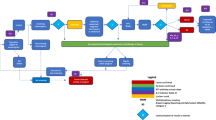Abstract
In a sequential OSCE which has been suggested to reduce testing costs, candidates take a short screening test and who fail the test, are asked to take the full OSCE. In order to introduce an effective and accurate sequential design, we developed a model for designing and evaluating screening OSCEs. Based on two datasets from a 10-station pre-internship OSCE and considering three factors, namely, the number of stations, the criteria for selecting the stations, and the cut-off score, several hypothetical tests were proposed. To investigate their accuracy, the positive predictive value (PPV), the pass rate, and the negative predictive value (NPV) were calculated. Also, a “desirable” composite outcome was defined as PPV = 100 %, pass rate ≥50 %, and NPV ≥25 %. Univariate and multiple logistic regression analyses were conducted to estimate the effects of independent factors on the occurrence of the desirable outcome. In half of the screening tests no false positive result was detected. Most of the screening OSCEs had acceptable levels of pass rate and NPV. Considering the desirable composite outcome 20 screening OSCEs could have successfully predicted the results of the corresponding full OSCE. The multiple regression analysis indicated significant contributions for the selection criteria (p values = 0.019) and the cut-off score (p values = 0.017). In order to have efficient screening OSCEs with the lowest probability of the error rate, careful selection of stations with high values of discrimination or item total correlation, and use of a relatively stringent cut-off score should be considered.
Similar content being viewed by others
References
Boursicot, K. A., Roberts, T. E., & Pell, G. (2007). Using borderline methods to compare passing standards for OSCEs at graduation across three medical schools. Medical Education, 41, 1024–1031.
Brannick, M. T., Erol-Korkmaz, H. T., & Prewett, M. (2011). A systematic review of the reliability of objective structured clinical examination scores. Medical Education, 45, 1181–1189.
Cass, A., Regehr, G., Reznick, R., Rothman, A., & Cohen, R. (1997). Sequential testing in the objective structured clinical examination: selecting items for the screen. Academic Medicine, 72(10 Suppl 1), S25–S27.
Colliver, J. A., Markwell, S. J., Travis, T. A., Schrage, J. L. & Vu, N. V. (1995). Sequential testing with a standardized patient examination: A ROC analysis of the effects of case total correlations and difficulty levels of screening test cases. In Proceedings of the sixth Ottawa conference on medical education (pp. 170–173). University of Toronto Bookstore, Customs Publishing.
Colliver, J. A., Mast, T. A., Vu, N. V., & Barrows, H. S. (1991). Sequential testing with a performance based examination using standardized patients. Academic Medicine, 66(suppl), S64–S66.
Colliver, J. A., Vu, N. V., & Barrows, H. S. (1992). Screening test length for sequential testing with a standardized-patient examination: A receiver operating characteristic (ROC) analysis. Academic Medicine, 67, 592–595.
Cookson, J., Crossley, J., Fagan, G., McKendree, J., & Mohsen, A. (2011). A final clinical examination using a sequential design to improve cost-effectiveness. Medical Education, 45, 741–747.
Currie, G. P., Selvaraj, S., & Cleland, J. (2015). Sequential testing in a high stakes OSCE: Determining number of screening tests. Medical Teacher, 16, 1–7.
De Champlain, A. F., Clauser, B. E., Margolis, M. J., Klass, D. J., & Nungester, R. J. (1998). Assessing decision consistency with a sequentially administered large-scale standardized patient examination: A Monte Carlo investigation. Academic Medicine, 73(10 Suppl), S78–S80.
Gormley, G. (2011). Summative OSCEs in undergraduate medical education. Ulster Medical Journal, 80, 127–132.
Harden, R. (2015). Misconceptions and the OSCE. Medical Teacher, 15, 1–3.
Khan, K. Z., Gaunt, K., Ramachandran, S., & Pushkar, P. (2013). The objective structured clinical examination (OSCE): Organisation and administration. AMEE guide no. 81. Part II: Medical Teacher, 35, e1447–e1463.
McKinley, D. W., & Norcini, J. J. (2014). How to set standards on performance-based examinations: AMEE guide no. 85. Medical Teacher, 36, 97–110.
Mortaz Hejri, S., Jalili, M., Muijtjens, A. M. M., & Van der Vleuten, C. P. M. (2013). Assessing the reliability of the borderline regression method as a standard setting procedure for objective structured clinical examination. Journal of Research in Medical Sciences, 18, 887–891.
Muijtjens, A. M., van Vollenhoven, F. H., van Luijk, S. J., & van der Vleuten, C. P. (2000). Sequential testing in the assessment of clinical skills. Academic Medicine, 75, 369–373.
Pell, G., Fuller, R., Homer, M., & Roberts, T. (2010). How to measure the quality of the OSCE: A review of metrics–AMEE guide no. 49. Medical Teacher, 32, 802–811.
Pell, G., Fuller, R., Homer, M., & Roberts, T. (2013). Advancing the objective structured clinical examination: Sequential testing in theory and practice. Medical Education, 47, 569–577.
Rothman, A. I., Blackmore, D. E., Dauphinee, W. D., & Reznick, R. (1997). Tests of sequential testing in two years’ results of Part 2 of the Medical Council of Canada Qualifying Examination. Academic Medicine, 72(10 Suppl 1), S22–S24.
Smee, S. M., Dauphinee, W. D., Blackmore, D. B., et al. (2003). A sequenced OSCE for licensure: Administrative issues, results and myths. Advances in Health Sciences Education, 8, 223–236.
Swanson, D. B., & Norcini, J. J. (1989). Factors influencing reproducibility of tests using standardized patients. Teaching and Learning in Medicine, 1, 158–166.
Tavakol, M., & Dennick, R. (2011). Post-examination analysis of objective tests. Medical Teacher, 33, 447–458.
van der Vleuten, C. P. M., & Swanson, D. B. (1990). Assessment of clinical skills with standardized patients: State of the art. Teaching and Learning in Medicine, 2, 58–76.
Funding
This project was part of a Ph.D. thesis supported and funded by Tehran University of Medical Sciences.
Author information
Authors and Affiliations
Corresponding author
Ethics declarations
Conflict of interest
None.
Ethical approval
The thesis proposal had been approved by the Postgraduate Studies Council in School of Medicine, Tehran University of Medical Sciences (code No. 8921486007).
Rights and permissions
About this article
Cite this article
Mortaz Hejri, S., Yazdani, K., Labaf, A. et al. Introducing a model for optimal design of sequential objective structured clinical examinations. Adv in Health Sci Educ 21, 1047–1060 (2016). https://doi.org/10.1007/s10459-016-9673-x
Received:
Accepted:
Published:
Issue Date:
DOI: https://doi.org/10.1007/s10459-016-9673-x




